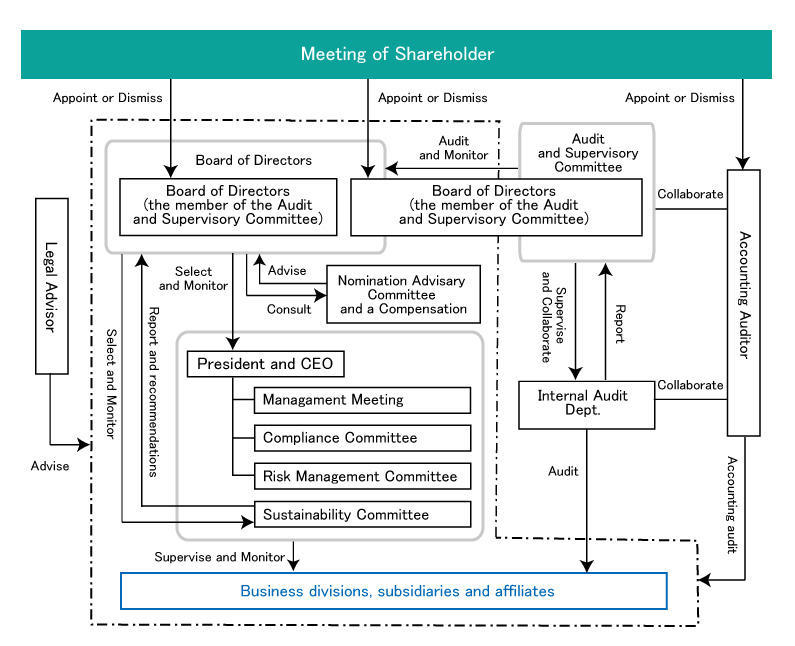Corporate Governance
Basic Approaches
One of our managerial priorities is to keep increasing our Company's value all the while exemplifying corporate governance and ethics, and we believe that the keys to that aim lie in timely strategic decision-making and sound business management. We are, therefore, committed to enhancing our corporate governance structure by further strengthening, improving and maintaining the legally-obligatory functions such as shareholders' meeting, board of directors, audit and supervisory committee, and accounting auditor, in addition to building good relationships with our stakeholders including shareholders, clients, regional communities and employees.
We also make our best efforts to promptly and accurately disclose information to our shareholders and investors as well as widely provide it to the public toward higher management transparency.
Our Corporate Governance Structure

As part of our efforts to stably keep increasing our Company's value over a long time ahead, we endeavor to build ever better relationships with our stakeholders through good communication and enhance the management transparency in the global environment by fulfilling our social responsibilities.
We pursue to make our technologies, products and Company to be "particular ones" that you cannot find anywhere else in the world and to thereby contribute to the progress of advanced technology industry and make our customers and the whole society happier, because that is the strategy we believe in for establishing a "stable and sustainable management basis."
Overview of the Corporate Governance Structure
Board of Directors
The Board of Directors chaired by Representative Director, President and Chief Executive Officer is composed of 13 Directors and held once a month in principle and on an ad hoc basis as needed. The Board of Directors makes decisions on matters stipulated by the laws and regulations, Articles of Incorporation, and Board of Directors Rules, important business execution, and management strategies. It also analyzes the management performance and differences between budgets and results and reports the status of duties executed by Directors, etc. We are making efforts to become a highly transparent organization, e.g., by obtaining useful advice from Outside Directors in the processes of decision-making and reporting at the Board of Directors and using their advice in the execution of business operations. It consists of 10 male Directors and 3 female Director.
Audit and Supervisory Committee
The Audit and Supervisory Committee chaired by Chairperson of the Audit and Supervisory Committee is composed of 6 Directors (Audit and Supervisory Committee Members) and held once a month in principle and on an ad hoc basis as needed. It strengthens the cooperation and shares information with the internal audit division and Accounting Auditor based on the audit policy and audit plan formulated at the Audit and Supervisory Committee, tries to establish an appropriate audit system, and audits the duties executed by Directors.
Accounting Auditor
The financial audit is conducted in accordance with the Companies Act and the Financial Instruments and Exchange Act based on the audit contract concluded with Ernst & Young ShinNihon LLC. They conduct audits and reviews of the full-year and quarterly financial results as an independent third party. We receive reports on problems, etc. occurring in the course of auditing, etc. as appropriate. We also receive reports on the results of audits, etc. and the effectiveness of internal control related to financial reports. We respond to inadequacies, etc., if any, in a timely manner.
Nomination Advisary Committee and a Compensation Advisary Committee
The Nomination Advisory Committee and Compensation Advisory Committee chaired by Representative Director, President and Chief Executive Officer is composed of 3 Directors as a voluntary advisory body of the Board of Directors and held several times a year. It deliberates and reports the appropriateness of the executive appointment and compensation of Directors according to the consultation of the Board of Directors. The Board of Directors determines matters about executive appointment and compensation of Directors based on the reports from the Nomination Advisory Committee and Compensation Advisory Committee.
Management Meeting
The Management Meeting chaired by Representative Director, President and Chief Executive Officer is composed of Directors (excluding Directors who are Audit and Supervisory Committee Members), the Chairperson of the Audit and Supervisory Committee, Head of each division, and others and held once a month in principle. It deliberates and resolves execution cases of each division and also plays a role as a body that makes agile decisions on management execution and smoothly conveys management information by receiving reports on management information from each division.
Compliance Committee
The Compliance Committee chaired by Representative Director, President and Chief Executive Officer is composed of 7 Directors and 1 Director (Audit and Supervisory Committee Member) and held at least once every half year and on an ad hoc basis as needed. It manages and handles the compliance-related problems in our company and our group and thus implements and operates compliance measures to contribute to the sound and appropriate operations of the management and business execution.
Risk Management Committee
The Risk Management Committee chaired by Representative Director, President and Chief Executive Officer is composed of 7 Directors and held at least once every half year and on ad hoc basis as needed according to the Risk Management Rules. It identifies and grasps risk issues for various risks in our company and our group and discusses and evaluates the risk measures for each business operation and the operation status.
Sustainability Committee
The Sustainability Committee, chaired by a director and composed of 2 other directors and 7 heads of division, is held at least once every half year and on an ad hoc basis as necessary to formulate the basic policy and overall plan for the company's sustainability, monitor progress, evaluate and verify the results of activities, and report and make recommendations to the Board of Directors.